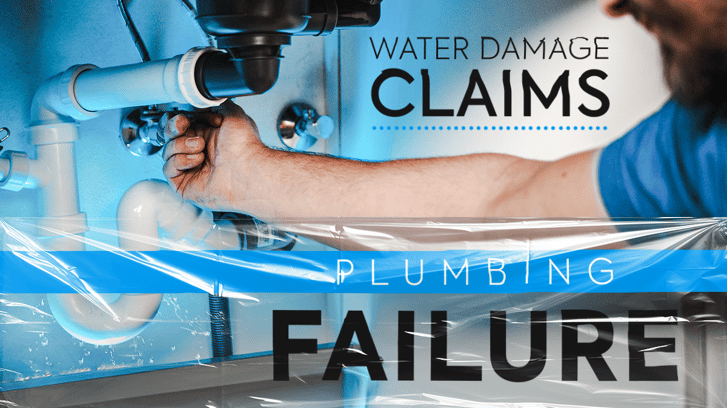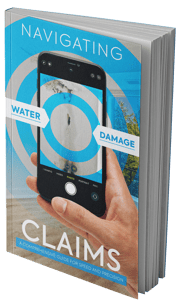Claims Adjuster
How to Evaluate Water Damage Claims When Suspecting Plumbing Failure

As a claims adjuster, you may have to investigate a water damage insurance claim from time to time. In this type of scenario, your role will be crucial for determining the extent of the damage and coverage eligibility. And that will require a careful assessment if plumbing failure is a suspected cause. Below, we have listed the five essential steps for completing this type of water damage assessment.
1. Study the Insured’s Policy and Claim
Before you even set foot on that person’s property, you will want to review the applicable policy. Look for details related to water damage, including any specific provisions related to plumbing components (such as burst pipe insurance coverage). Take note of the water damage insurance coverage limits, deductibles, and any exclusions that may apply. This information will be the foundation of your assessment.
Next, review the initial claim documents submitted by the policyholder. These documents can provide valuable insights into the nature of the damage, its suspected cause and timeline, and any immediate actions taken to mitigate the situation.
2. Interview the Policyholder
Once you arrive on-site, engage in a detailed discussion with the policyholder. Ask about the history of the plumbing system, any recent plumbing maintenance or repairs, and when and where they first noticed the water damage. Gathering this information will help you create a clearer picture of the situation.
3. Determine the Extent of Water Damage
After your chat with the policyholder is complete, you can move on to investigating the water damage and its relation to plumbing components.
Begin with a visual inspection of the affected area. Look for visible signs of water damage, such as wet or discolored walls, ceilings, and flooring. Check for mold. Pay attention to any musty odors, which may indicate long-term moisture issues. Also, utilize diagnostic tools such as moisture meters and thermal imaging cameras to identify hidden sources of moisture and potential plumbing issues.
Next, focus on the property’s visible plumbing components. Inspect pipes, valves, and water fixtures for any obvious issues. Check for signs of corrosion, leaks, or loose connections.
4. Identify the Source of the Damage
Pinpointing the source of the water damage is a critical step in determining coverage eligibility. The source could possibly be one of the following:
- A Burst Pipe or Plumbing Leak: If you identify a burst pipe or leak as the source of the damage, assess the condition of the affected plumbing components. Determine whether the damage resulted from wear and tear, inadequate maintenance, or a sudden event like freezing temperatures.
- Faulty Fixtures: In cases where a faulty fixture, such as a faucet or a water heater, is responsible for the damage, investigate whether the malfunction was due to a manufacturing defect, normal wear and tear, or negligence in maintenance.
- External Causes: Occasionally, water damage may result from an external cause, such as flooding or a sewer backup. Investigate whether the damage was a consequence of a covered event or if it falls under an exclusion in the policy.
5. Document Your Findings
Accurate documentation of your findings is crucial for supporting your claim assessment. Utilizing a floor plan app such as magicplan can streamline this process by allowing you to complete multiple steps in a short amount of time:
Measure and Sketch Affected Rooms Speedily and Accurately
Using a floor plan app for sketching will save a lot of time. To start a new sketch, simply open your app, tap appropriate buttons to start a new project, and then scan a water-damaged room with your mobile-device camera. Your app will sync with the camera to capture measurements and sketch a floor plan automatically.
Enhance Your Sketch with Water-damage and Plumbing Details in a Swift Manner
Once your sketch is finished, you can document your inspection observations by inserting specific details. These can be objects (plumbing fixtures, appliances, etc.) and also descriptive annotations, such as:
- Source/cause of the interior water damage
- Locations of water damage
- The extent of the damage
- The type of water involved
- Readings from hygrometers, moisture meters, thermal-imaging cameras and other tools
- Notations about plumbing failures, if applicable
- Mitigation work that has been completed already to stabilize the scene
- Restoration solutions that will be required
Add Photos Easily
Take in-app photos of any issues you detected during your inspection. Then use your digital app to quickly attach those photos to your floor plan sketch. You can even add brief but descriptive captions to those photos for clarification.
Summarize Your Findings Rapidly in a Digital Water-damage Report
An accurate report will serve as written evidence that you completed an inspection. The key to creating one efficiently is to make sure you have a floor plan app with built-in reporting capabilities. This will enable you to convert any floor plan sketch into a detailed water-damage inspection report. You can do this right at the jobsite, after you complete your investigation. Then you can share your report electronically with the policyholder and the insurance company before you leave the property. That way it’s done that same day and not hanging over your head. Plus, you’re one step closer to closing that claim and getting paid.
Conclusion
Assessing any claim that may involve plumbing failure requires a systematic approach. By studying the pertinent policy and claim documents, interviewing the policyholder, determining the extent of water damage, identifying the source of the damage, and using a floor plan app for documentation, you can ensure a thorough and accurate evaluation. This will help enable a fair and swift resolution.
READ MORE:
How Home-Insurance Claims Adjusters Can Benefit from ISO Claim Search
Related articles
Bernd Wolfram
Head of Product

